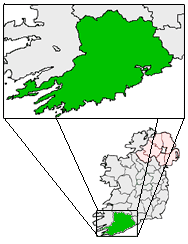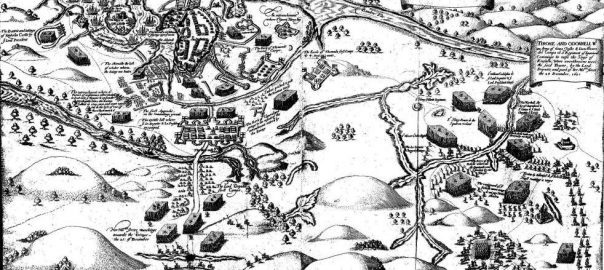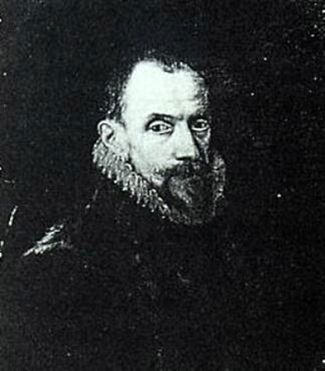In 1601 CE, the big stories covered earlier continued to unfold: the Earl of Essex’s ill-planned little (possible) revolt in February; the East India Company’s launching of its first fleet in April. The new big stories of the year were as noted above. Ireland first, then Matteo Ricci.
Big defeat for the Irish in Kinsale
1599 CE had seen the tactically smart Irish forces inflicting a resounding defeat on the Earl of Essex. Now, in 1601, Queen Elizabeth was relying on a commander who was somewhat more capable: Charles Blount, Lord Mountjoy (whose mistress was Essex’s sister Penelope, for what it’s worth.) Like Essex, Mountjoy was a dandy and sybarite; but he had some military and alliance-building acumen.

The main leaders on the Irish resisters’ side were, as in 1599, Hugh O’Neill and Red Hugh O’Donnell; and they had support from Spain’s new-ish king Philip III, as they had had from his dad. In summer 1601, Philip sent a well-armed force of 6,000 men under the seasoned fighter Don Juan del Águila to help them, but “bad weather separated the ships and nine of them, carrying the majority of veteran soldiers and gunpowder, had to turn back.” The remaining 4000 men disembarked at Kinsale, just south of Cork in southwest Ireland on 2 October 1601.” Another Spanish force landed at the village of Baltimore. The Spaniards rushed to fortify these beach-heads before the English could arrive.
As soon as Mountjoy heard about the Spanish arrivals, he assembled a force that marched across Ireland from Ulster to go and confront them. Arriving at Kinsale first, he started to besiege the Spanish there. (The banner image above is a depiction of the siege and battle of Kinsale, from Pacata Hibernia, 1633.)
O’Neill, O’Donnell, and their ally Richard Terrell also hurried to go down in three separate columns and meet up with the Spanish. (From their point of view, the Spanish had landed in completely the wrong place, but they had to go and connect with them.) O’Neill’s was the first Irish column to arrive, and he positioned his men on a ridge northwest of town. When Mountjoy heard of this, he left a skeleton force on the siege lines and went to confront O’Neill’s force there.
Then, this:
O’Neill controlled the ridge, and intended to fight for it, with support from Del Aguila, O’Donnell, and Tyrell on multiple sides. Del Águila was an experienced soldier and put up a fierce defence. His instructions were, however, to hold the town until the Irish army came down from Ulster to combine with them. When neither of his allies showed signs of movement, O’Neill ordered a retreat into the marshes, hoping to mire the English cavalry in the soft land. In the end, the Irish were overpowered by the English cavalry, who charged through O’Neill’s men, and prevented a flanking maneuver by O’Donnell.
The tactics showed that the Irish infantry were poorly trained for pitched battle in formation against a well-drilled professional army. It also showed the strength of the English cavalry techniques using the lance, as compared with the Irish method of no stirrup and overhead spear throwing.
The Irish army left the field in some disorder while a supporting Spanish army… tried to obstruct the English charge and the ensuing massacre of the Irish. Most of the Irish fled back to Ulster.
Del Águila saw his position as hopeless. He negotiated a surrender of Kinsale with Mountjoy that allowed him to sail back to Spain with his colors flying. (He did not know that another Spanish force had been sent and was within a few days of arriving. That force never landed. On hearing of Del Águila’s surrender, they turned round and sailed back to Spain.)
English-WP concludes:
This loss put an end to Spanish help in Ireland and to much of the Irish resistance. The Ulster forces returned to their home province, and after two more years of attrition, the last of them surrendered in 1603, just after the death of Queen Elizabeth. In the following year England and Spain agreed to make peace with the signing of the Treaty of London.
O’Donnell went to Castlehaven and took a ship to Spain… O’Neill returned to his native Ulster and continued to fight, but his aura of invincibility was broken. He submitted to the crown at Mellifont on 30 March 1603, where he received generous terms. Four years later he decided to go to Spain. O’Neill was accompanied by many supporters and other chieftains. This is known as the “Flight of the Earls”. Their intention was always to raise an army and oust English authority in their home province, but the territories they had left behind were soon divided up in the Plantation of Ulster, and they were never able to return.
The English administration saw the ideal opportunity to seize most of the land of Ulster, and to bring in Presbyterian Lowland Scots and northern English settlers to farm it…
The result of the Battle of Kinsale was devastating to the existing Irish culture and way of life, as the old Gaelic system was finally broken. As the Gaelic aristocracy fled to continental Europe, they left behind a power vacuum that the authority of the English filled.
Matteo Ricci enters Beijing
In 1582, we had left the Jesuit priest/adventurer Matteo Ricci in Zhaoqing, where he continued his pretty impressive work as a linguist, mathematician, and cartographer. In the intervening years he had traveled some around China; and in 1598 he and a Jesuit colleague had compiled a second Chinese-Portuguese dictionary, “in which tones in Chinese syllables were indicated in Roman text with diacritical marks.”
Now, in 1601, the Wanli Emperor invited him to become an advisor to the imperial court, and he was thus the first Westerner to be invited into Beijing’s Forbidden City. This honor was a recognition of his scientific skills– reportedly, the chief among these was his ability to predict solar eclipses, regarded as significant events in the Chinese world.
Ricci was given free access to the Forbidden City but never met the ever-reclusive Wanli Emperor. But the emperor gave him a generous stipend and supported his completion of the Zhifang Waiji, China’s first global atlas.

Oh, and Ricci was also allowed to establish a chapel, which later became a Catholic cathedral. When he died in 1610, the emperor allowed the Jesuits to bury him, as he had wished, in Beijing– in the grounds of a specially designated Buddhist temple.

